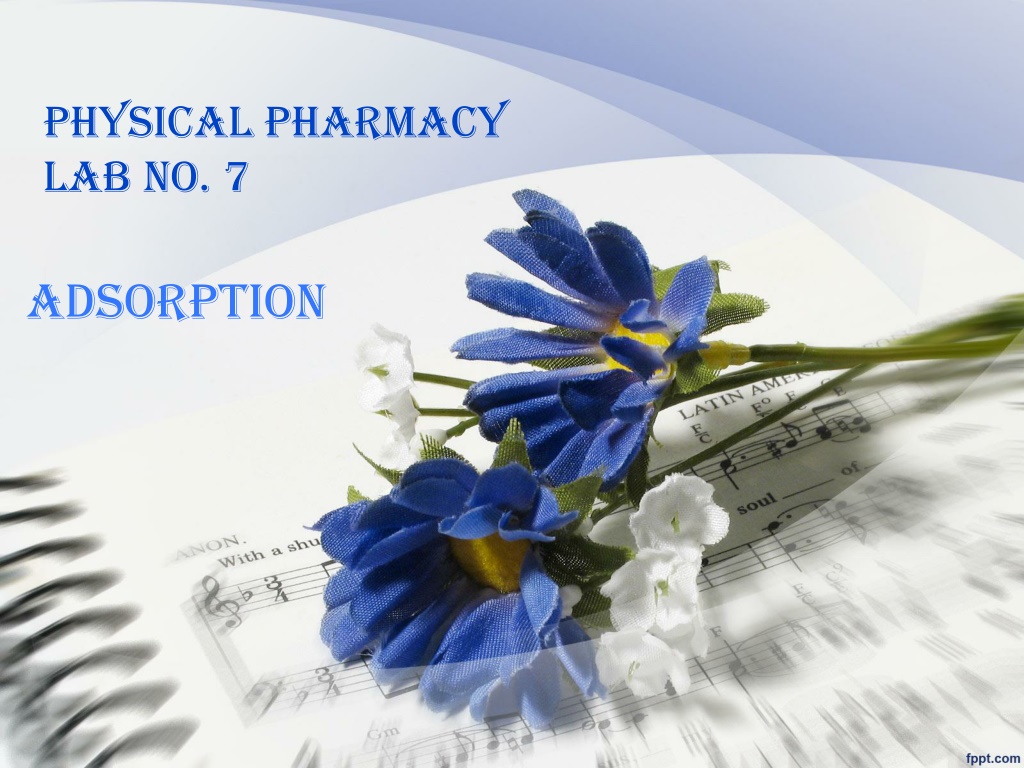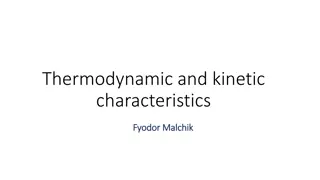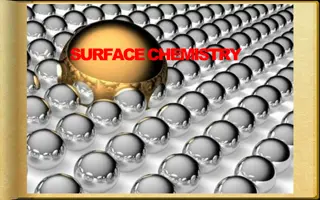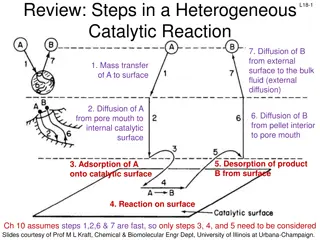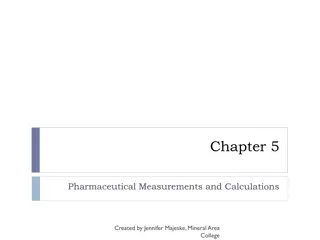Understanding Adsorption Process in Physical Pharmacy Lab
Adsorption is a significant process in physical pharmacy involving the attachment of solutes or gaseous molecules onto the surface of a solid. This process can be strong or weak depending on the forces between the solid surface and the gas/solute. Types include physical (reversible) and chemical (irreversible) adsorption, each with unique characteristics. Various factors like surface area, nature of adsorbate, pH, temperature, and nature of the adsorbent influence adsorption. Applications range from odor removal to chromatography.
Download Presentation

Please find below an Image/Link to download the presentation.
The content on the website is provided AS IS for your information and personal use only. It may not be sold, licensed, or shared on other websites without obtaining consent from the author. Download presentation by click this link. If you encounter any issues during the download, it is possible that the publisher has removed the file from their server.
E N D
Presentation Transcript
Physical pharmacy Lab No. 7 Adsorption
Adsorption Adsorption is a process of free moving of solutes or gaseous molecules of a solution come close and attach themselves onto the surface of solid. The adsorption can be strong or weak depends on the nature of forces between solid surface (adsorbent) and the gas or dissolves solute (adsorbate), as shown below:
Adsorption adsorption:- is the process which is involve the concentration or accumulation of gas ,liquid and solid on the surface of the liquid or solid which is in contact . solid has the property of holding molecules at their surface and this property occur in the case of porous and finely divided material. adsorbent:- is the material used to adsorb gas ,liquid and solid e.g. charcoal & kaolin adsorbate:- is the substance being adsorbed. adsorption isotherm:- is the relationship between the amount of substance being adsorbed and the amount existing in the bulk of the solution at constant temperature.
Types of adsorption:- 1- physical or vanderwaals adsorption associated with vanderwaals force and it is reversible . the removal of adsorbate from adsorbent known as desorption , as physically adsorbed gas can be desorbed from solid by increasing temperature and decreasing pressure. 2- chemical or chemisorptions in which adsorbate is attached to adsorbent by primary chemical bond and is irreversible
Type of adsorption 1- Heat of adsorption 2-specifity 3-reversibility 4-effect of temperature. Criterea Physical Low(4 kcal/mole) Non-spesific Reversible Decrease with increasing temperature. 20 kcal/mole Spesific Irreversible Increase or decrease with increase temperature. Chemical
Application of adsorption: the removable of objectionable odor from room & food. the operation of gas mask and measurement of particle dimension. decoloring of solution ,detergent and wetting . adsorption chromatography.
factors affecting on adsorption process Adsorption on a solid is influenced by a number of factors such as, Surface area Nature of the adsorbate Hydrogen ion concentration (pH) of the solution Temperature Mixed solutes and Nature of adsorbent
Freundlich adsorption isotherm freundlich derived an empirical equation for the absorption of the dissolved solid on the surface of porous substance. x/m = k? log x/m = log k + 1/n log P where x is the weight of the gas adsorbed by m gm of the adsorbent at a pressure p, thus x/m represents the amount of gas adsorbed by the adsorbents per gm (unit mass), k and n are constant at a particular temperature and for a particular adsorbent and adsorbate (gas), n is always greater than one, indicating that the amount of the gas adsorbed does not increase as rapidly as the pressure. 1?(Freundlich adsorption isotherm) or
according to freundlich equation a plot of log x/m versus log P a straight line obtained and the constant k and 1/n determined ( intercept = log k, slop = 1/n ) Log C or
Experimental work Aim of the experiment is to study the adsorption of oxalic acid on kaolin and see the effect of increasing the concentration of oxalic acid on adsorption. Materials and equipments:- -oxalic acid, D.W., NaOH, kaolin -solutions:- 1 N oxalic acid,0.5 N NaOH, ph.ph indicator -volumetric flask (50 cc)conical flask , pipette (20 cc), filter paper ,funnel, burette.
Procedure :- 1- prepare 50ml of the following concentration of oxalic acid ( 0.2 , 0.4 , 0.6 , 0.8 N ) from stock solution of 1N oxalic acid. 2- put 50 ml of each concentration and stock solution in 5 conical flasks. 3-introduce 2gm kaolin into each flask. 4- shake for 15 min. ,set aside for another 15 min to achieve equilibrium. 5-filter, reject the first portion of the filtrate after washing the receiver with it . 6- pipette 20 ml of the filtrate containing the non-adsorbed oxalic acid (free) and titrate them with 0.5 N NaOH using phenolphthalein indicator ( End point change in color from colorless to pink) 7- calculate the amount adsorbed in each flask and plot freundlich adsorption isotherm , find the values of K and 1/n.
Calculation:- total amount of oxalic acid - free amount = adsorbed amount . during titration:- O O C OH C ONa C OH + 2 NaOH C ONa O O 1mole oxalic acid 2 mole NaOH 1 M.Wt ox.A 2 * 1 M * 1L NaoH 126/2 1000 ml 1 N NaOH 63*0.5/1000 1ml 0.5 N NaOH 0.0315 gm ox.A 1ml 0.5N NaOH E.P.* 0.0315 = gm ox.A (free) /20 ml
Calculate the amount of total oxalic acid in each flask as follows:- flask no.1:- if there is no kaolin present and we take 20 ml of solution and titrate it with 0.5 N NaOH theoretically it take 40 ml NaOH 1mole oxalic acid = 2 mole NaOH 1 M * V ox.A = 2 M * V NaOH 2 N * V ox.A = 2 N * V NaOH 1 * 20 = 0.5 * V V= 40 ml NaOH we need if there is no kaolin present in the flask 40* 0.0315 = 1.26 gm oxalic acid /20 ml (total) = 3.15 gm ox.A /50 ml ...............................in flask no.1 x=amount adsorbed = 3.15 -[ (E.P1 * 0.0315)*50/20]= gm/50ml adsorbed of oxalic acid (X)
repeat the calculation for the other 4 flasks to find amount of oxalic acid /50ml that is adsorbed - C% can be calculated as follows:- for flask no. 1 ( concentration = 1 N) ?? * 1000 ??? N = ??.?? 1 = wt*1000 / 63*100 c%= 6.3 gm of oxalic acid /100ml repeat the calculation for the other flasks to find C%
Tabulate the result as follow Flask no. Conc. of oxalic acid 1N LogC% E.P. x/m Log x/m C% 1 2 0.8N 3 0.6N 4 0.4N 5 0.2N
